ikfoundation.org
Promoting Natural & Cultural History



ESSAYS |
LIONS, STARS AND POMEGRANATES
from southern Sweden
Southernmost Sweden had an unusually rich textile tradition, which within the farmers’ households reached its peak between 1750 to 1850. My first research project was based on these historically influential textiles, of which their techniques and patterns were developed into magnificent works of art; in turn being inspired by the culture and design traditions of ancient and prehistoric cultures.
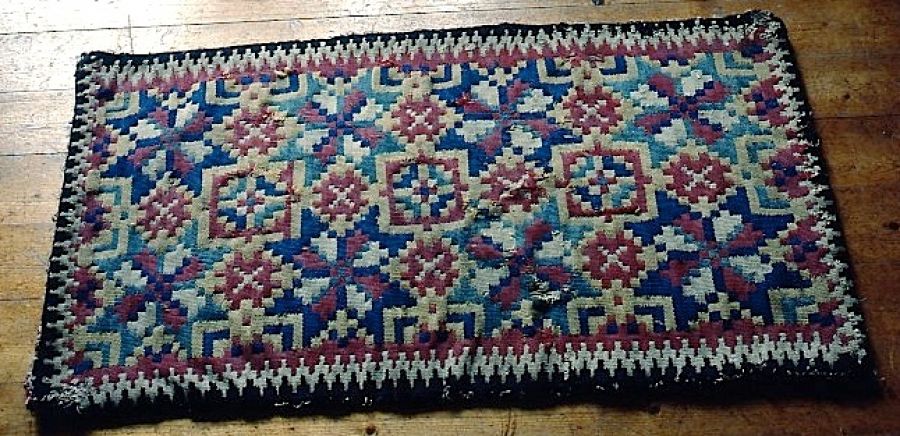 Double interlocked tapestry with eight-sided stars and star variations. Luggude, Skåne, Sweden, late 18th century. (Owner: Stiftelsen Jöns Jons gården). Photo: The IK Foundation, London.
Double interlocked tapestry with eight-sided stars and star variations. Luggude, Skåne, Sweden, late 18th century. (Owner: Stiftelsen Jöns Jons gården). Photo: The IK Foundation, London.Double interlocked tapestry – or “rölakan” – was a technique that was practised in many parts of Scandinavia during the 18th and 19th centuries. The publication Textila Kuber och Blixtar examines all the aspects of “rölakan”, which includes the materials used, colours, sizes, markings and the people who worked with and created these works. The book also looks at the patterns through a historical context in how they have, over time, moved across continents and cultures. The book is based upon a research project that was carried out during the period 1985 to 1991, involving documentation of almost 2.000 textiles throughout northern Europe; it can be read and enjoyed as it is or used as a reference work. This book has been published as a limited edition, illustrated with classic and beautiful examples of these tapestries. There are over 400 photographs and drawings, half of which are in colour.
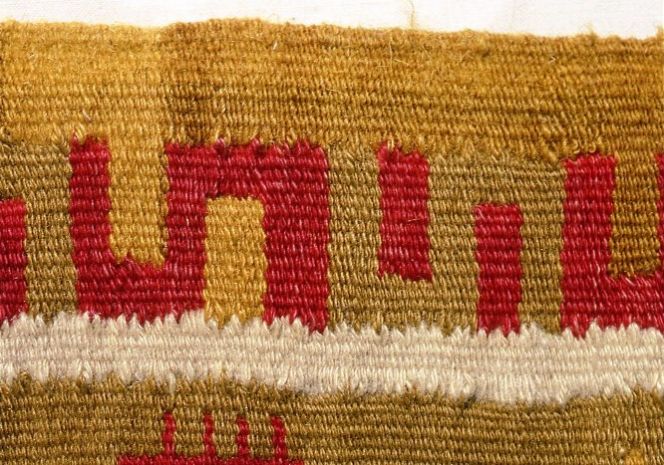 Close-up detail of the double interlocked tapestry technique. Herrestad, Skåne, Sweden, early 19th century. (Owner: Malmö museums). Photo: The IK Foundation, London.
Close-up detail of the double interlocked tapestry technique. Herrestad, Skåne, Sweden, early 19th century. (Owner: Malmö museums). Photo: The IK Foundation, London.Patterns and their history: Humans have always sought to decorate and embellish their lives, the patterns and their beauty have been of great importance to us. There are countless theories from where such patterns emanate and the context in which they were made, at the same time, it becomes possible to track the paths these patterns have taken as they have traversed cultures over centuries and millennia. We should not, however, forget that several of the more basic patterns could have been spontaneously developed in several different locations without any connection. Primarily, this covers basic motifs such as zigzags, squares, lines and stars. Many of these could be drawn from nature, which served as an inspiration when human sources were not present. Examples of this can be seen in the past and today throughout several cultures, where simple patterns are created repeatedly, from the basis of available materials and techniques.
At first glance, there seems to be an endless myriad of patterns which span textile history, but soon we can define groupings within the mass, be it from Coptic textiles dating to 5th century AD in Egypt to early 19th century Swedish tapestries. The use of patterns sometimes stretches far beyond this scale of time and geographical areas, whilst humans universally seem to have preferred symmetry and repetition. Furthermore, the space is usually filled in a structured manner, which can be seen in many cultures as a sort of caution/fear of leaving empty spaces and the possibility of destroying the symmetry. The similarities within the woven patterns are striking, whilst regional characteristics led to a diffusion of available materials and colours in reflecting the opportunities in different cultures.
A pattern which was already in use throughout the Etruscan period on today’s Italian peninsula (circa 400 BC) was called either the pomegranate or the palmate. The motif is seen to originate from China and stands for virility and immortality, which explains its popularity in combination with its beauty.
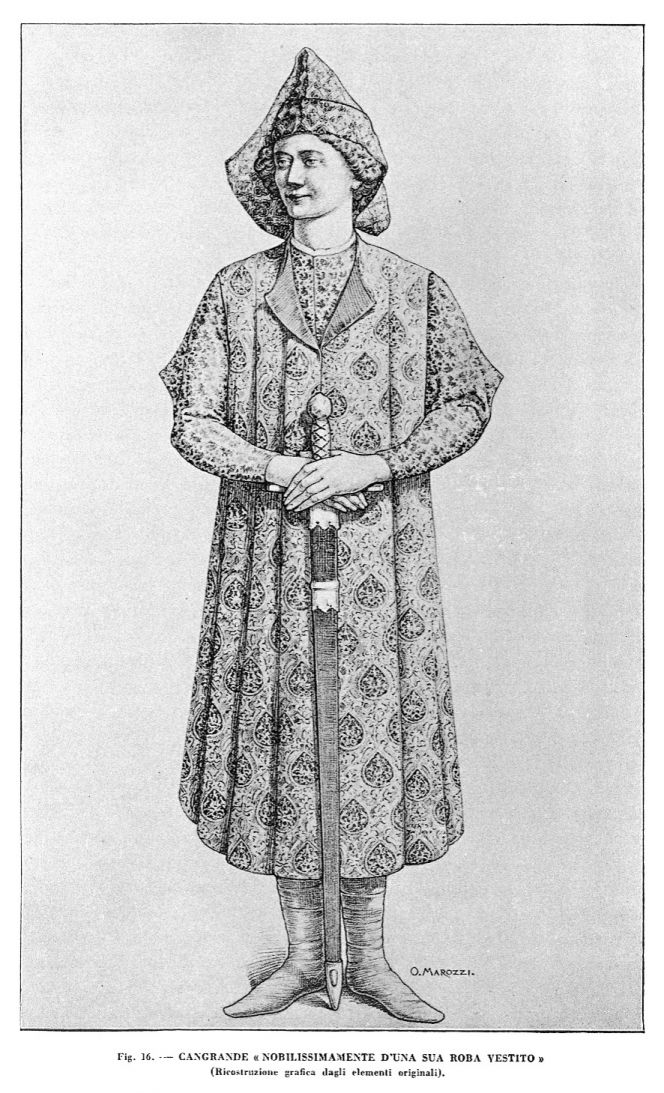 The pomegranate can be traced through history, but it reached great popularity in Italy during the 14th to 16th centuries, both within ecclesiastic and noble spheres, an example of this can be seen here in this portrait of a young nobleman (14th century). It is due to the artists of the renaissance enthusiasm in depicting these textiles that we today can study them in-depth. The portraiture of the time serves as a vital primary source in studying the motif of the clothes, mats, cushions and other upholstery. All those who could afford it; the church, nobles, monarchs, sought to own these luxurious textiles. (Sangiorgi, Giorgio, Contributi allo studio dell’arte textile, Roma 1920).
The pomegranate can be traced through history, but it reached great popularity in Italy during the 14th to 16th centuries, both within ecclesiastic and noble spheres, an example of this can be seen here in this portrait of a young nobleman (14th century). It is due to the artists of the renaissance enthusiasm in depicting these textiles that we today can study them in-depth. The portraiture of the time serves as a vital primary source in studying the motif of the clothes, mats, cushions and other upholstery. All those who could afford it; the church, nobles, monarchs, sought to own these luxurious textiles. (Sangiorgi, Giorgio, Contributi allo studio dell’arte textile, Roma 1920).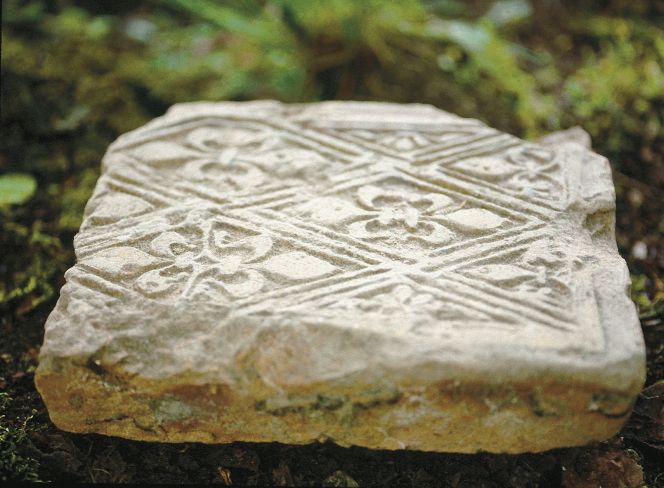 A quite similar motif – the lily – probably reached Scandinavia through the assistance of travelling monks during the early Middle Ages or even through the Vikings. The lily can among many places be seen in Herrevad’s monastery in Skåne on a beautiful floor tile (13th century). Photo: The IK Foundation, London.
A quite similar motif – the lily – probably reached Scandinavia through the assistance of travelling monks during the early Middle Ages or even through the Vikings. The lily can among many places be seen in Herrevad’s monastery in Skåne on a beautiful floor tile (13th century). Photo: The IK Foundation, London.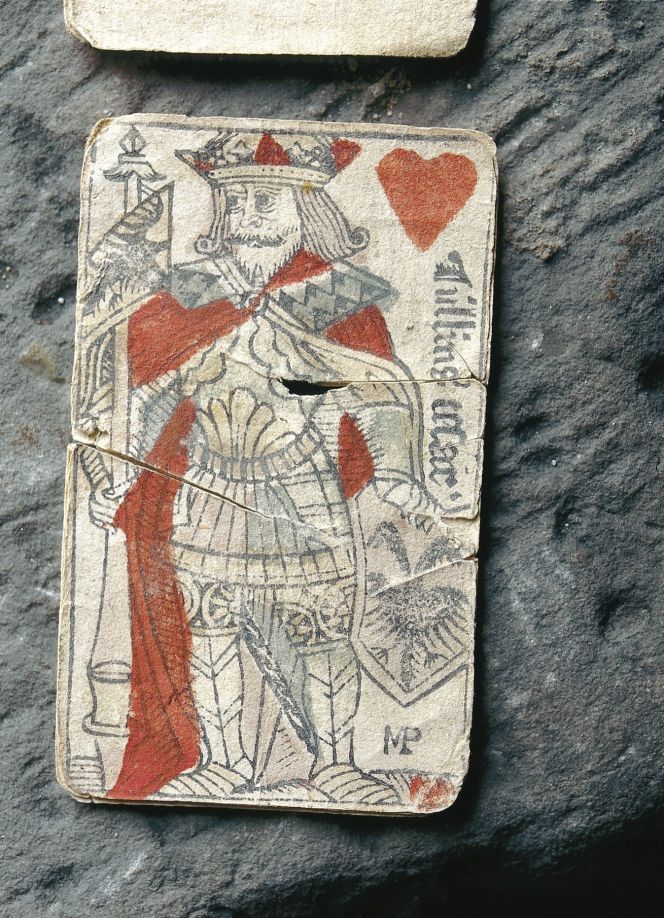 A later example which relates to a playing card from the 16th century, where the pictured monarch carries an exquisite mantle and beneath a pomegranate can be seen on his clothes. (Lund Cathedral, Sweden). Photo: The IK Foundation, London.
A later example which relates to a playing card from the 16th century, where the pictured monarch carries an exquisite mantle and beneath a pomegranate can be seen on his clothes. (Lund Cathedral, Sweden). Photo: The IK Foundation, London.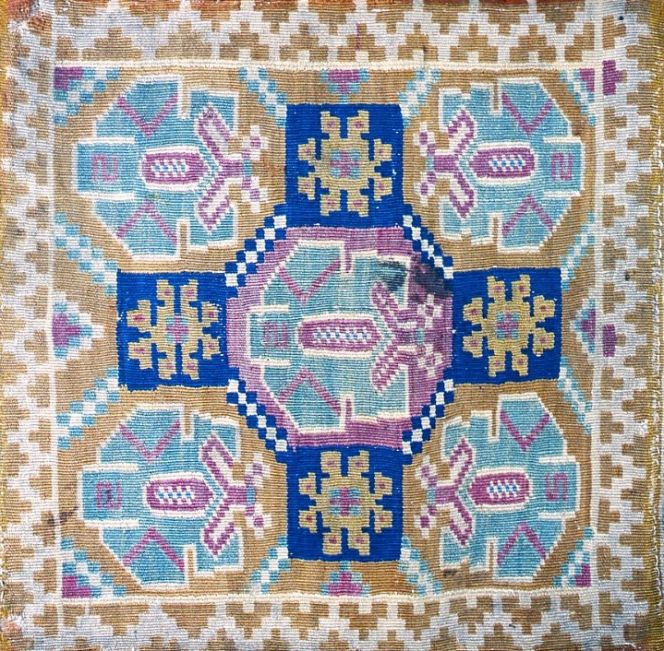 The pomegranate became most popular in southern Sweden, Skåne within woollen embroidery, double interlocked tapestry and “Flemish” tapestries in the period 1700 to 1850. Here depicted with a “rölakan” cushion from Villand district in Skåne, early 19th century. (Private ownership). Photo: The IK Foundation, London.
The pomegranate became most popular in southern Sweden, Skåne within woollen embroidery, double interlocked tapestry and “Flemish” tapestries in the period 1700 to 1850. Here depicted with a “rölakan” cushion from Villand district in Skåne, early 19th century. (Private ownership). Photo: The IK Foundation, London.Depictions of lions have also had a wide geographical diffusion throughout its long history. Even this composition – usually within a circular or octagonal framework – became part of the weaving and embroidery traditions in Skåne (c. 1700-1850s). An advanced pattern which showed you were a proficient weaver. One of the earliest lion-like figures has been portrayed and also framed in a medallion – just like the ones from Skåne – originating from the 6th century AD Syria. The motif can be studied on preserved textiles and stone reliefs.
 This photograph shows a selection of textiles with lions; two colourful tapestries woven by farmers’ wives and daughters of south eastern Skåne (late 18th century), together with a Coptic textile (5th to 7th century AD) and Italian filet lace (16th century). (Owner: Malmö museums). Photo: The IK Foundation, London.
This photograph shows a selection of textiles with lions; two colourful tapestries woven by farmers’ wives and daughters of south eastern Skåne (late 18th century), together with a Coptic textile (5th to 7th century AD) and Italian filet lace (16th century). (Owner: Malmö museums). Photo: The IK Foundation, London.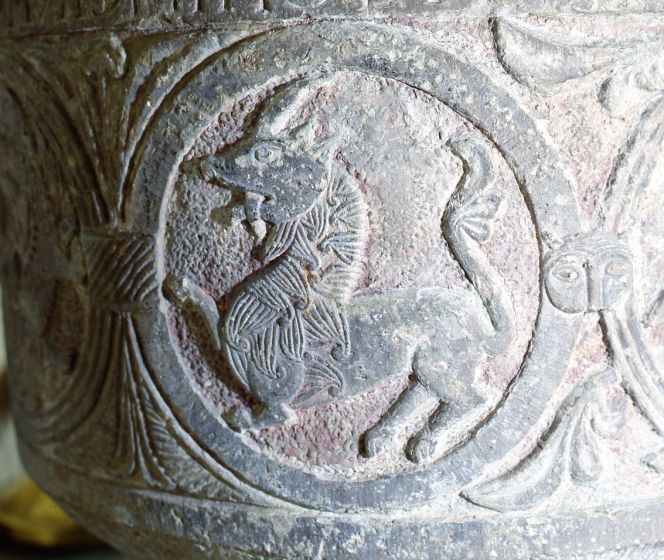 The lion within the medallion-like frame was already well known in Scandinavia during the early medieval period, here depicted on a stone relief on the font of Dalby church in Skåne, Sweden. Which is believed to be the oldest preserved stone church in Scandinavia (11th century). Photo: The IK Foundation, London.
The lion within the medallion-like frame was already well known in Scandinavia during the early medieval period, here depicted on a stone relief on the font of Dalby church in Skåne, Sweden. Which is believed to be the oldest preserved stone church in Scandinavia (11th century). Photo: The IK Foundation, London.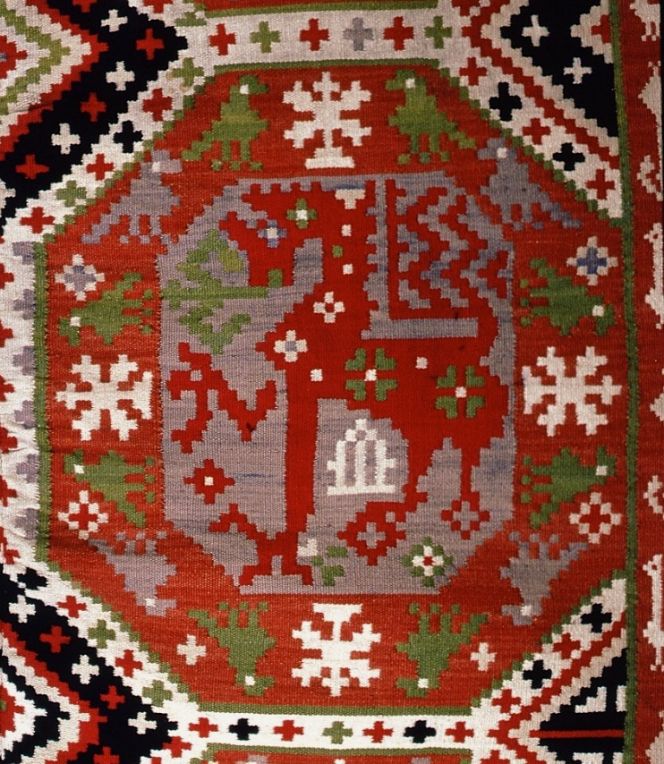 Double interlocked tapestry with lion within eight-sided frame, part of bedcover. Färs, Skåne, Sweden, c. 1800. (Owner: Regionmuseet, Kristianstad). Photo: The IK Foundation, London.
Double interlocked tapestry with lion within eight-sided frame, part of bedcover. Färs, Skåne, Sweden, c. 1800. (Owner: Regionmuseet, Kristianstad). Photo: The IK Foundation, London.In these descriptive patterns, it is clear that humans, over long periods of time, developed a love for symmetry, direction and patterns, regardless of where they were. It can also be said that patterns from the simplest constructs to the most advanced frameworks have been a key inspiration for driving art and manufacturing at said time. Also, when production was bound to manufacturing guilds, embroidery for pleasure, textiles for the dowry or other reasons. The patterns have taken on an essential role alongside the materials and colours used in creating a result which was as beautiful as possible.
Sources:
- Hansen, Viveka, Textila Kuber och Blixtar – Rölakanets Konst- och Kulturhistoria, Christinehof 1992.
- Hansen, Viveka, Swedish Textile Art, London 1996.
- Sangiorgi, Giorgio, Contributi allo studio dell’arte tessile, Roma 1920.
Essays
The iTEXTILIS is a division of The IK Workshop Society - a global and unique forum for all those interested in Natural & Cultural History from a Textile Perspective.
Open Access essays - under a Creative Commons license and free for everyone to read - by Textile historian Viveka Hansen aiming to combine her current research and printed monographs with previous projects dating back to the late 1980s. Some essays also include unique archive material originally published in other languages, made available for the first time in English, opening up historical studies previously little known outside the north European countries. Together with other branches of her work; considering textile trade, material culture, cloth manufacturing, fashion, natural dyeing and the fascinating world of early travelling naturalists – like the "Linnaean network" – from a Global history perspective.
For regular updates, and to make full use of iTEXTILIS' possibilities, we recommend fellowship by subscribing to our monthly newsletter iMESSENGER.
been copied to your clipboard




– a truly European organisation since 1988
Legal issues | Forget me | and much more...








